Performance Improvement of a Straight-Bladed Darrieus Hydrokinetic Turbine through Enhanced Winglet Designs
Abstract
:1. Introduction
2. Methodology
2.1. Hydrodynamic Coefficients of HK Turbines
- Power coefficient:where is the power generated by the turbine and is the frontal area of the turbine. It must be noted that the value of is modified in the turbine configuration including winglets by accordingly increasing the blade height; this allows for a fair comparison with the coefficients obtained for the straight blade.
- Torque coefficient:where is the torque produced by the turbine.
- Tangential and normal force coefficients:where is the component of the hydrodynamic force over the blade that is parallel to the chord of the blade profile and is the component that is perpendicular to the chord of the blade profile as shown in Figure 1. This figure also identifies the location of the outer (extrados) and inner (intrados) blade surfaces.
- Tip speed ratio (TSR):Also, it is possible to obtain the pressure, Equation (6), and skin friction, Equation (7), coefficients as the non-dimensional numbers associated with the pressure and wall shear stress magnitude [24].
- Pressure and skin friction coefficients:where is the reference pressure.
2.2. Geometric Model
3. Mesh and Computational Set-Up
Results of Grid Convergence Analysis
4. Results and Discussion
4.1. Validation of Simulations versus Reference Study [7]
4.2. Performance of Winglet Models
4.3. Characterization of the Turbine and the Best Winglet Model at Different TSR Values
5. Examination of Flow Structures on Straight and Winglet Turbines
Analysis of the Behavior of Pressure and Skin Friction Coefficients
6. Conclusions
- While the W4560 design achieved the highest average power coefficient, similar performance enhancements were observed with winglet configurations featuring cant and sweep angles ranging from 30° to 45° and 45° to 60°, respectively, at .
- By analyzing the hydrodynamic coefficients and comparing the base case with the turbine equipped with winglets, it was found that the power generation increase occurs in the upstream region. The rise in such coefficients is generally observed as the turbine moves through azimuthal positions ranging from 30° to 140°.
- The performance improvement with winglets happens over the entire operational range and increases with a growing tip speed ratio.
- One of the main impacts of the winglets is the influence in the tip vortex. The shape, size and strength of the tip vortex are altered due to the presence of the winglets. A second, smaller tip vortex formation was clearly observed due to the symmetrical characteristics of the winglet design.
- Analysis through the flow visualization revealed that the use of winglets weakens the detached trailing vortices and delays the flow separation near the blade tip in the upstream cycle of the turbine. Both effects contribute to the observed increase in turbine power when using winglets.
- In the upper blade area near the tip, the pressure coefficient for the straight blade tends to equalize and become negative on both the pressure and suction sides, whereas in the winglet configuration, the pressure difference is sustained. Additionally, the skin friction coefficient tends to be higher in the SB than in the WB configuration.
Author Contributions
Funding
Institutional Review Board Statement
Informed Consent Statement
Data Availability Statement
Acknowledgments
Conflicts of Interest
References
- Kroes, M.J.; Nolan, M.S. Shapes and dimensions of airfoils. In Aircraft Basic Science, 8th ed.; McGraw-Hill Education: New York, NY, USA, 2013. [Google Scholar]
- Tong, G.; Yang, S.; Li, Y.; Feng, F. Effects of blade tip flow on aerodynamic characteristics of straight-bladed vertical axis wind turbines. Energy 2023, 283, 129105. [Google Scholar] [CrossRef]
- Trivedi, C.; Cervantes, M.J.; Gandhi, B.K. Investigation of a high head Francis turbine at runaway operating conditions. Energies 2016, 9, 149. [Google Scholar] [CrossRef]
- Lain, S.; Sommerfeld, M.; Quintero, B. Numerical simulation of secondary flow in pneumatic conveying of solid particles in a horizontal circular pipe. Braz. J. Chem. Eng. 2009, 26, 583–594. [Google Scholar] [CrossRef]
- Marsh, P.; Ranmuthugala, D.; Penesis, I.; Thomas, G. The influence of turbulence model and two and three-dimensional domain selection on the simulated performance characteristics of vertical axis tidal turbines. Renew. Energy 2017, 105, 106–116. [Google Scholar] [CrossRef]
- Lain, S.; Sommerfeld, M. A study of the pneumatic conveying of non-spherical particles in a turbulent horizontal channel flow. Braz. J. Chem. Eng. 2007, 24, 535–546. [Google Scholar] [CrossRef]
- Yagmur, S.; Kose, F.; Dogan, S. A study on performance and flow characteristics of single and double H-type Darrieus turbine for a hydro farm application. Energy Convers. Manag. 2021, 245, 114599. [Google Scholar] [CrossRef]
- Doan, M.N.; Obi, S. Numerical study of the dynamic stall effect on a pair of cross-flow hydrokinetic turbines and associated torque enhancement due to flow blockage. J. Mar. Sci. Eng. 2021, 9, 829. [Google Scholar] [CrossRef]
- Guillaud, N.; Balarac, G.; Goncalvès, E.; Zanette, J. Large Eddy Simulations on Vertical Axis Hydrokinetic Turbines—Power coefficient analysis for various solidities. Renew. Energy 2020, 147, 473–486. [Google Scholar] [CrossRef]
- Singh, E.; Roy, S.; Yam, K.S.; Law, M.C. Numerical analysis of H-Darrieus vertical axis wind turbines with varying aspect ratios for exhaust energy extractions. Energy 2023, 277, 127739. [Google Scholar] [CrossRef]
- Barbarić, M.; Batistić, I.; Guzović, Z. Numerical study of the flow field around hydrokinetic turbines with winglets on the blades. Renew. Energy 2022, 192, 692–704. [Google Scholar] [CrossRef]
- Kunasekaran, M.; Hyung Rhee, S.; Venkatesan, N.; Samad, A. Design optimization of a marine current turbine having winglet on blade. Ocean. Eng. 2021, 239, 109877. [Google Scholar] [CrossRef]
- Wang, Y.; Guo, B.; Jing, F.; Mei, Y. Hydrodynamic performance and flow field characteristics of tidal current energy turbine with and without winglets. J. Mar. Sci. Eng. 2023, 11, 2344. [Google Scholar] [CrossRef]
- Malla, A.; Han, Z.; Zhou, Z. Effect of a winglet on the Power Augmentation of Straight Bladed Darrieus Wind Turbine. IOP Conf. Ser. Earth Environ. Sci. 2020, 505, 012041. [Google Scholar] [CrossRef]
- Miao, W.; Liu, Q.; Xu, Z.; Yue, M.; Li, C.; Zhang, W. A comprehensive analysis of blade tip for vertical axis wind turbine: Aerodynamics and the tip loss effect. Energy Convers. Manag. 2022, 253, 115140. [Google Scholar] [CrossRef]
- Ghiss, M.; Bahri, Y.; Souaissa, K.; Troudi, H.; Ting, D.S.K.; Tourki, Z. Enhancing Vertical Axis Wind Turbine Performance Using Winglets. In Design and Modeling of Mechanical Systems-V. CMSM 2021; Lecture Notes in Mechanical Engineering; Springer: Cham, Switzerland, 2023. [Google Scholar] [CrossRef]
- Mishra, N.; Gupta, A.S.; Dawar, J.; Kumar, A.; Mitra, S. Numerical and Experimental Study on Performance Enhancement of Darrieus Vertical Axis Wind Turbine with Wingtip Device. J. Energy Resour. Technol. 2018, 140, 121201. [Google Scholar] [CrossRef]
- Sham, S.; Khamis, A.; Abdallftah, M.T.; Fares, M.; Shahid, S. CFD Analysis of Vertical Axis Wind Turbine with Winglets. J. Renew. Energy Res. Appl. 2021, 3, 51–59. [Google Scholar] [CrossRef]
- Cai, X.; Zhang, Y.; Ding, W.; Bian, S. The aerodynamic performance of H-type darrieus VAWT rotor with and without winglets: CFD simulations. Energy Sources Part A Recovery Util. Environ. Eff. 2019, 1–12. [Google Scholar] [CrossRef]
- Zhang, T.T.; Elsakka, M.; Huang, W.; Wang, Z.G.; Ingham, D.B.; Ma, L.; Pourkashanian, M. Winglet design for vertical axis wind turbines based on a design of experiment and CFD approach. Energy Convers. Manag. 2019, 195, 712–726. [Google Scholar] [CrossRef]
- Xu, W.; Li, G.; Wang, F.; Li, Y. High-resolution numerical investigation into the effects of winglet on the aerodynamic performance for a three-dimensional vertical axis wind turbine. Energy Convers. Manag. 2020, 205, 112333. [Google Scholar] [CrossRef]
- Laín, S.; Taborda, M.A.; López, O.D. Numerical Study of the Effect of Winglets on the Performance of a Straight Blade Darrieus Water Turbine. Energies 2018, 11, 297. [Google Scholar] [CrossRef]
- Manwell, J.F.; McGowan, J.G.; Rogers, A.L. Wind Energy Explained: Theory, Design and Application, 2nd ed.; Wiley: Chichester, UK, 2009. [Google Scholar]
- Roy, S.; Branger, H.; Luneau, C.; Bourras, D.; Paillard, B. Design of an offshore three-bladed vertical axis wind turbine for wind tunnel experiments. OMAE2017-61512. In Proceedings of the ASME 2017 36th International Conference on Ocean, Offshore and Arctic Engineering OMAE2017, Trondheim, Norway, 25–30 June 2017. [Google Scholar] [CrossRef]
- Steger, J.L.; Dougherty, F.; Benet, J.A. A Chimera Grid Scheme; The American Society of Mechanical Engineers: New York, NY, USA, 1983; Volume 5. [Google Scholar]
- Langtry, R.B.; Menter, F.R. Correlation-based transition modeling for unstructured parallelized computational fluid dynamics codes. AIAA J. 2009, 47, 2894–2906. [Google Scholar] [CrossRef]
- Laín, S.; Cortés, P.; López, O.D. Numerical Simulation of the Flow around a Straight Blade Darrieus Water Turbine. Energies 2020, 13, 1137. [Google Scholar] [CrossRef]
- Spentzos, A.; Barakos, G.; Badcock, K.; Richards, B.; Wernert, P.; Schreck, S.; Raffel, M. Investigation of Three-Dimensional Dynamic Stall Using Computational Fluid Dynamics. AIAA J. 2005, 43, 1023–1033. [Google Scholar] [CrossRef]
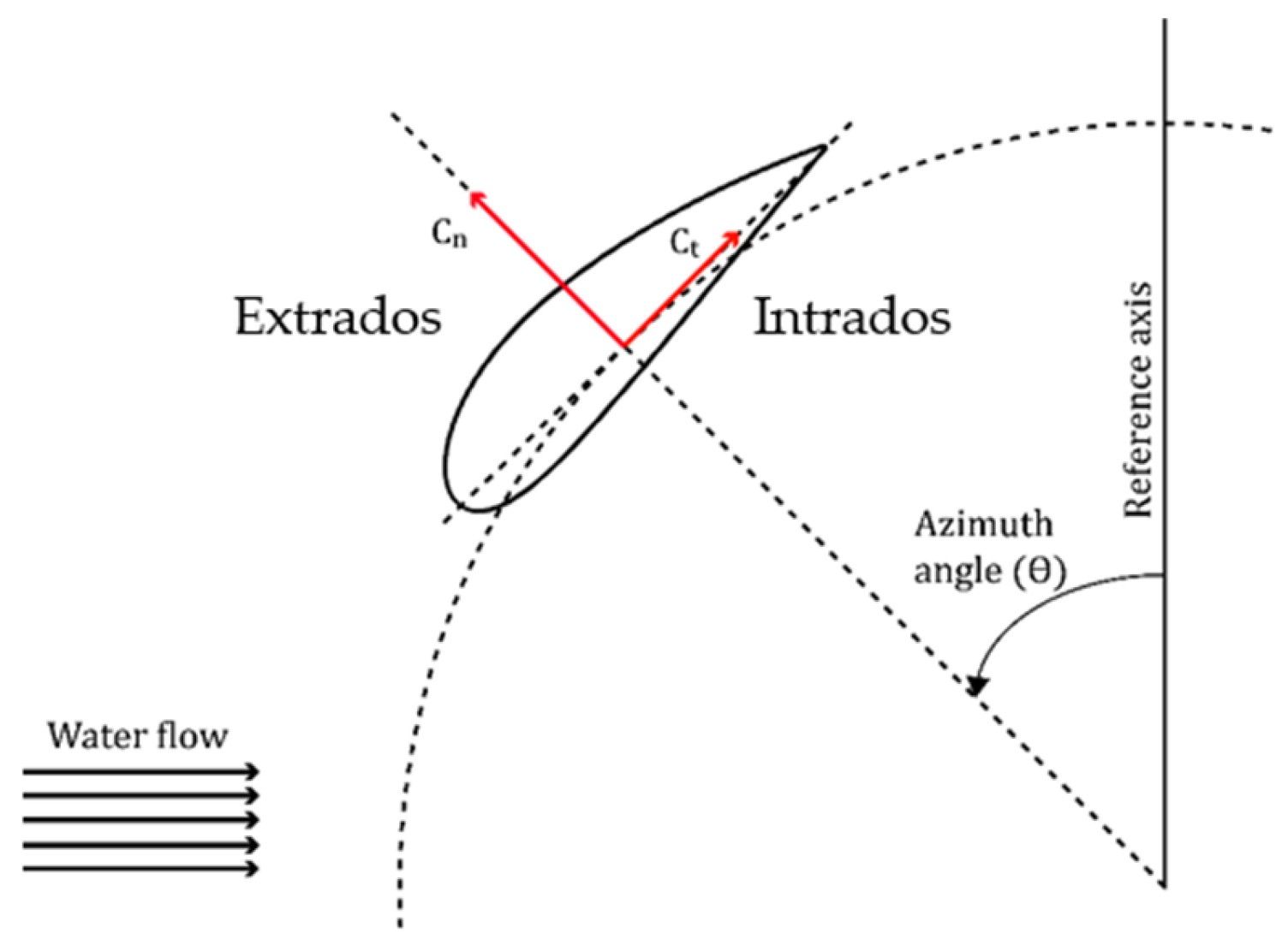


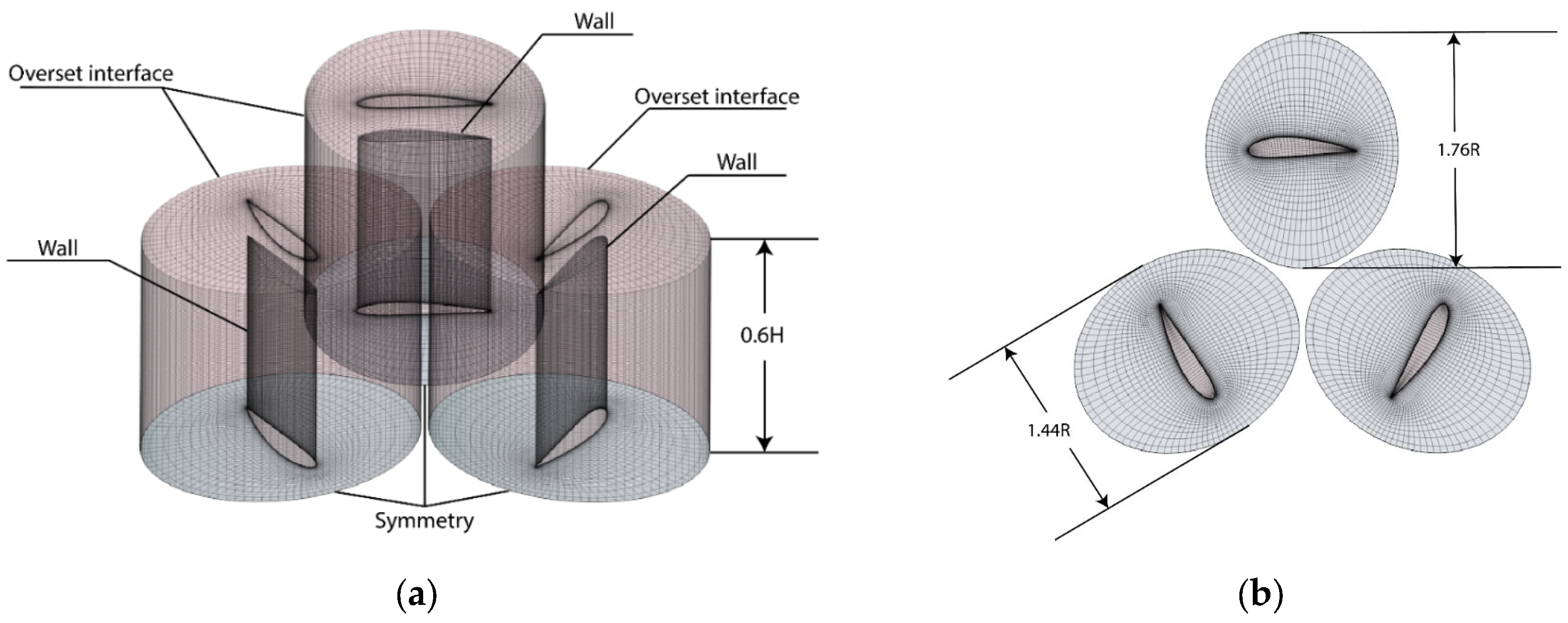
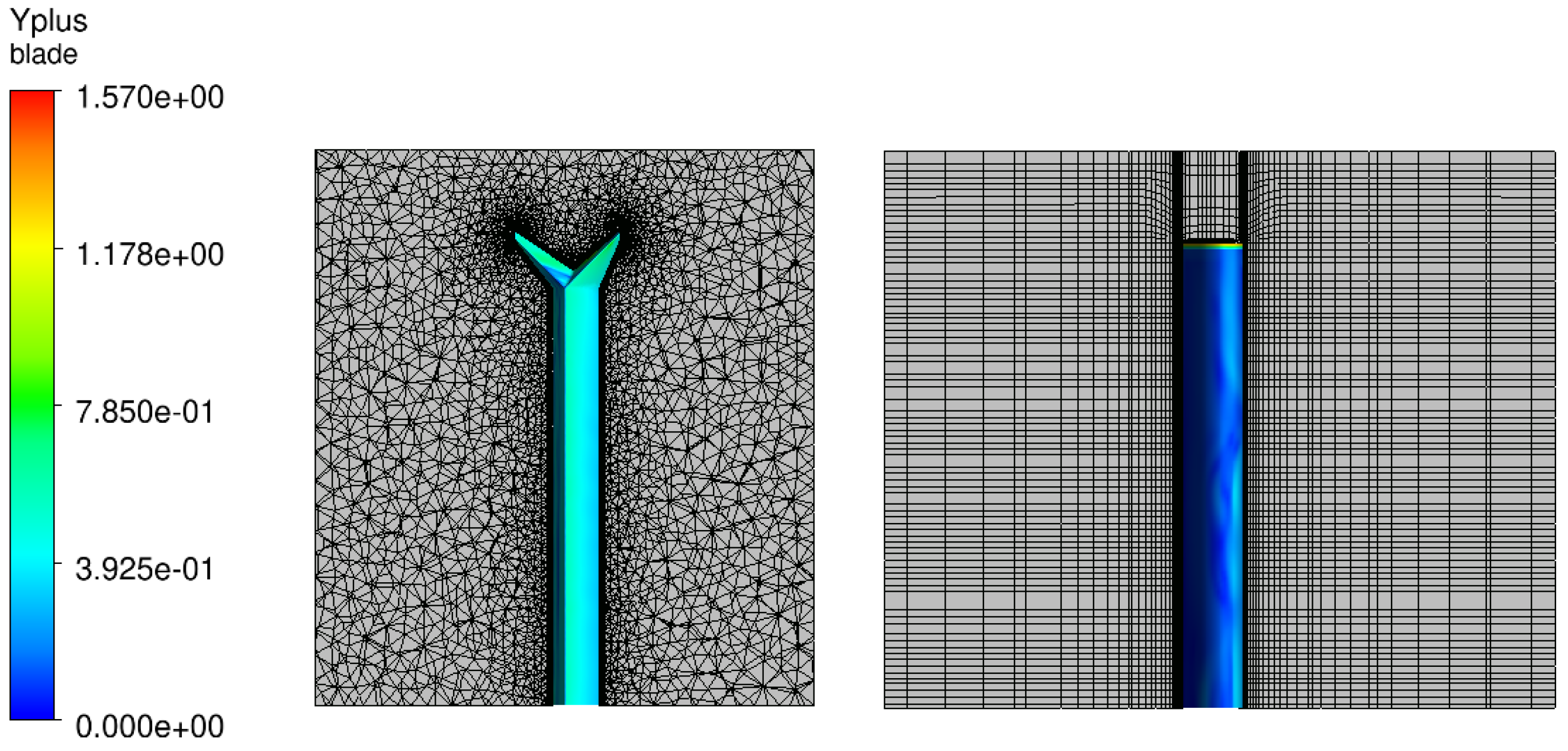

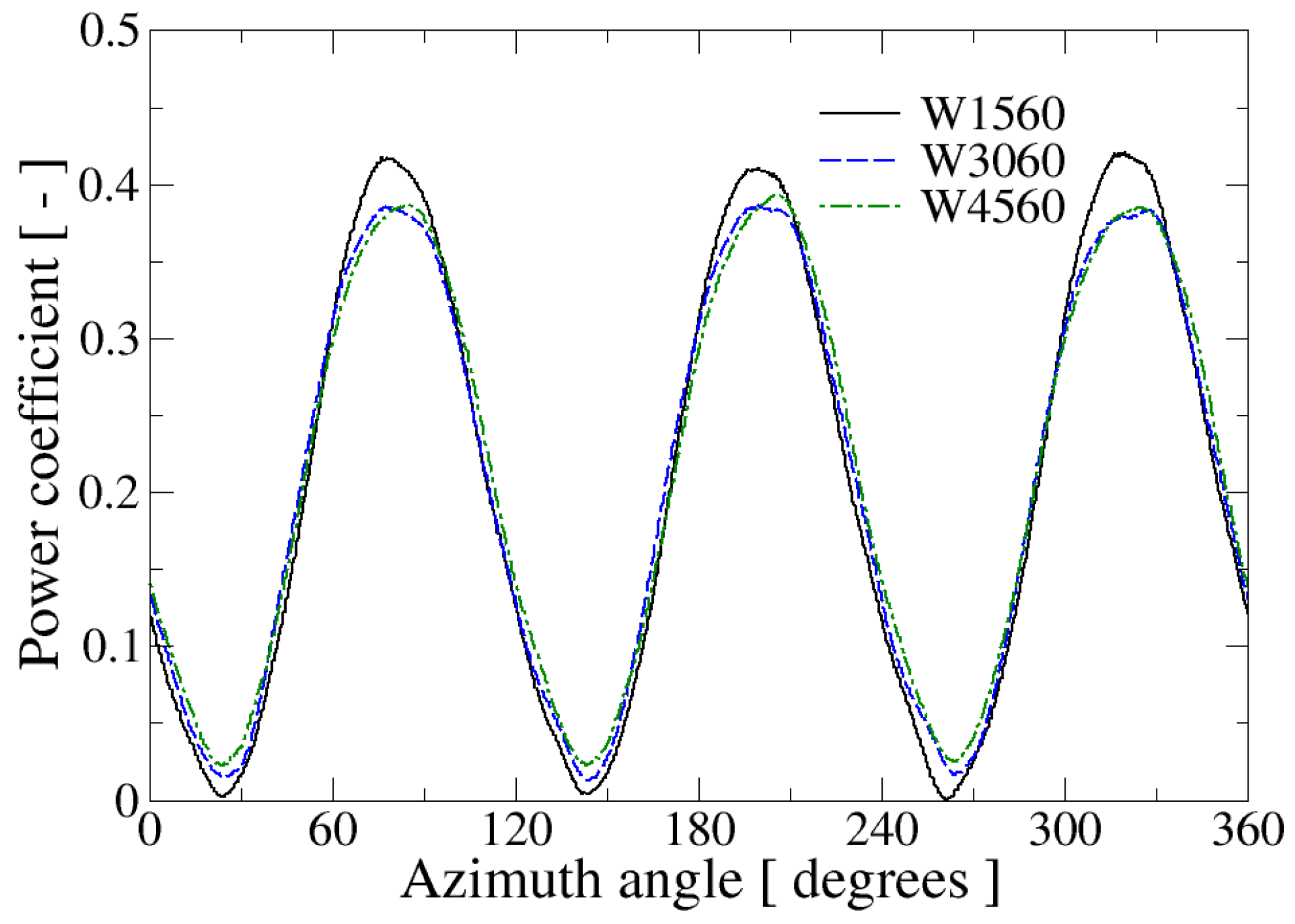
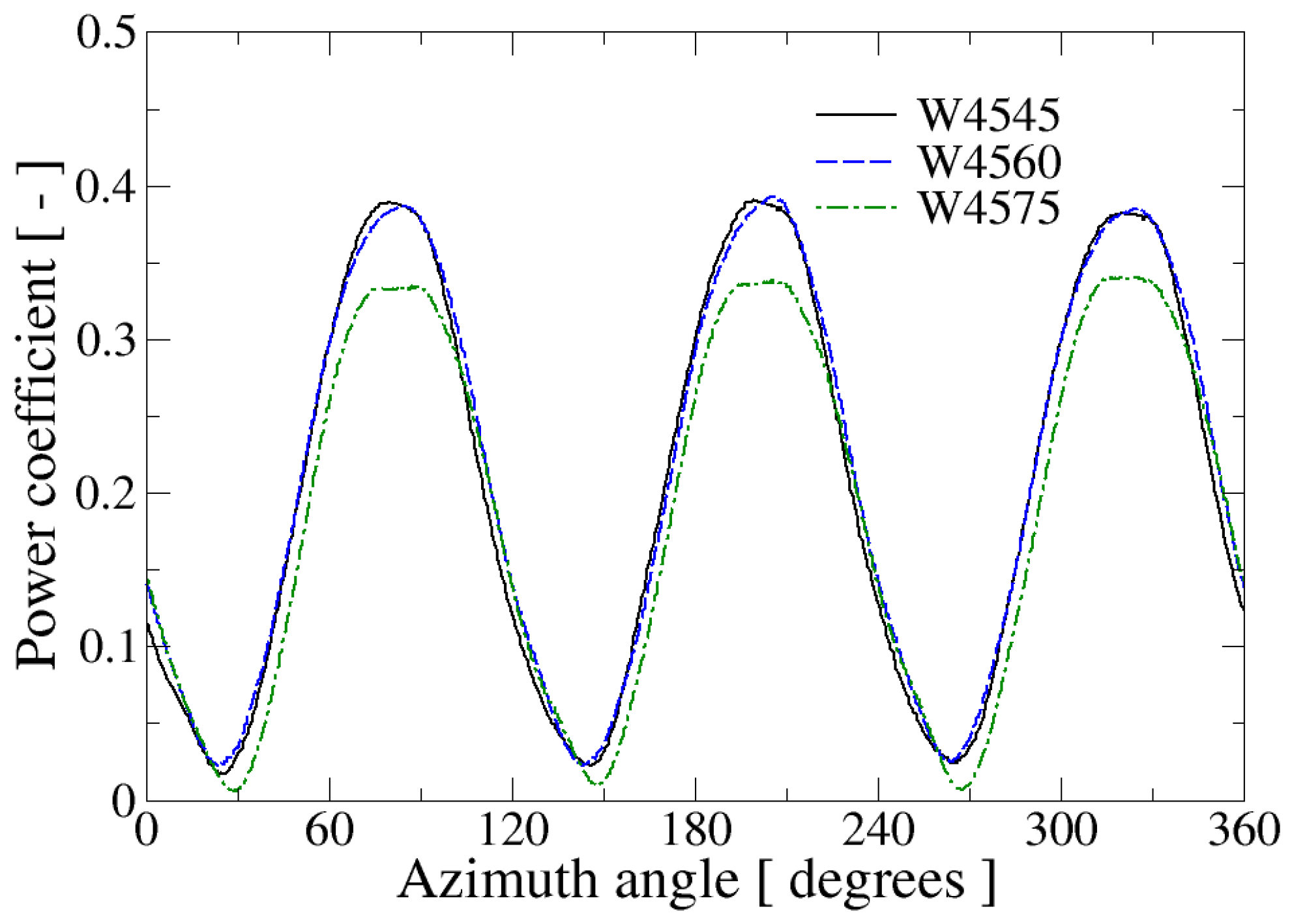
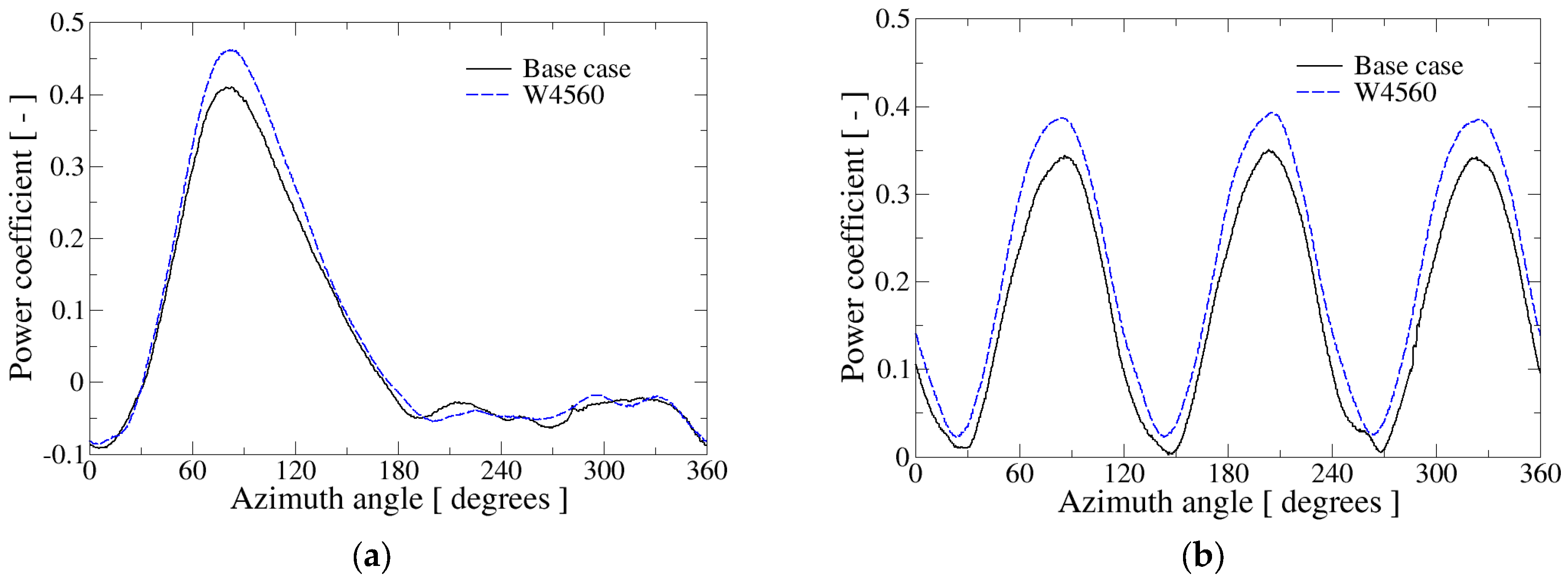
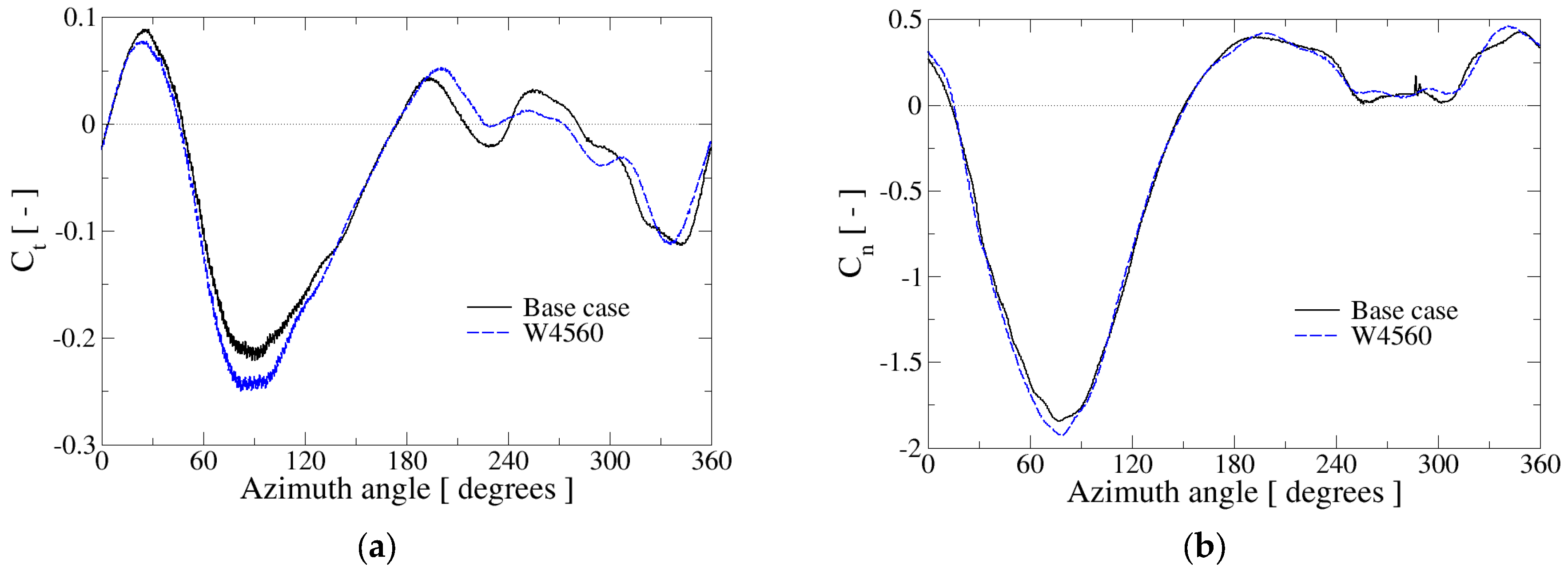
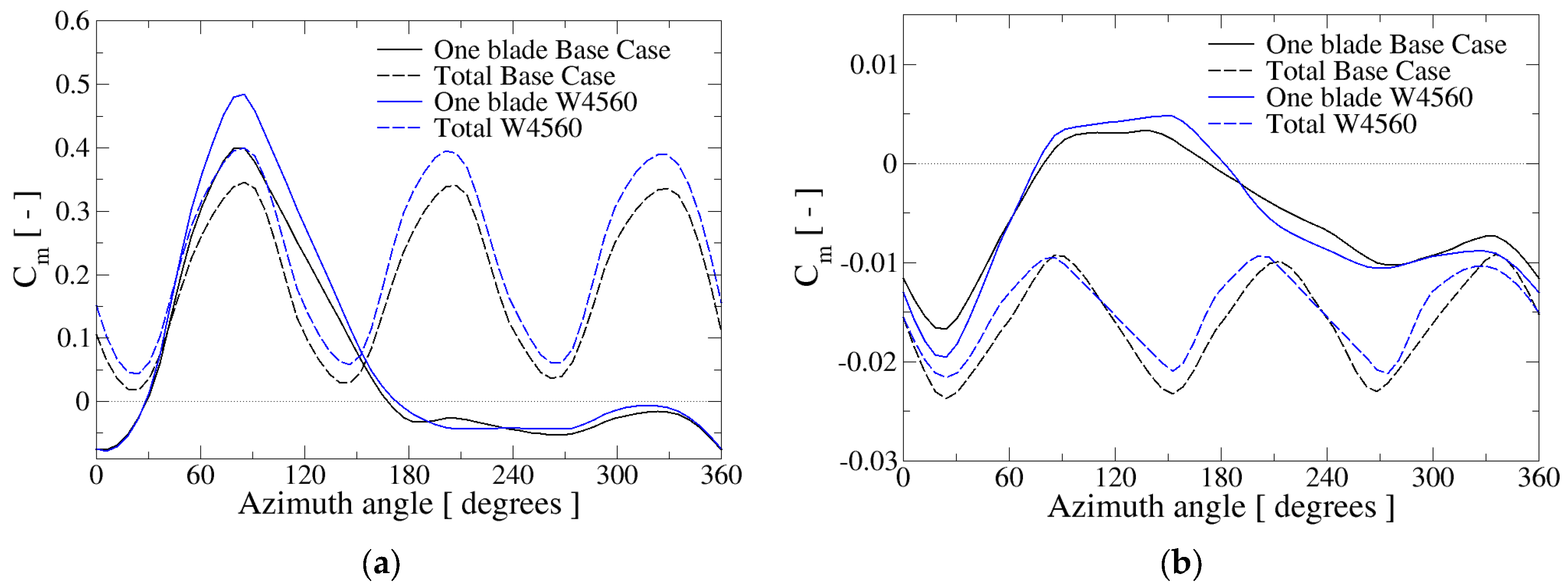
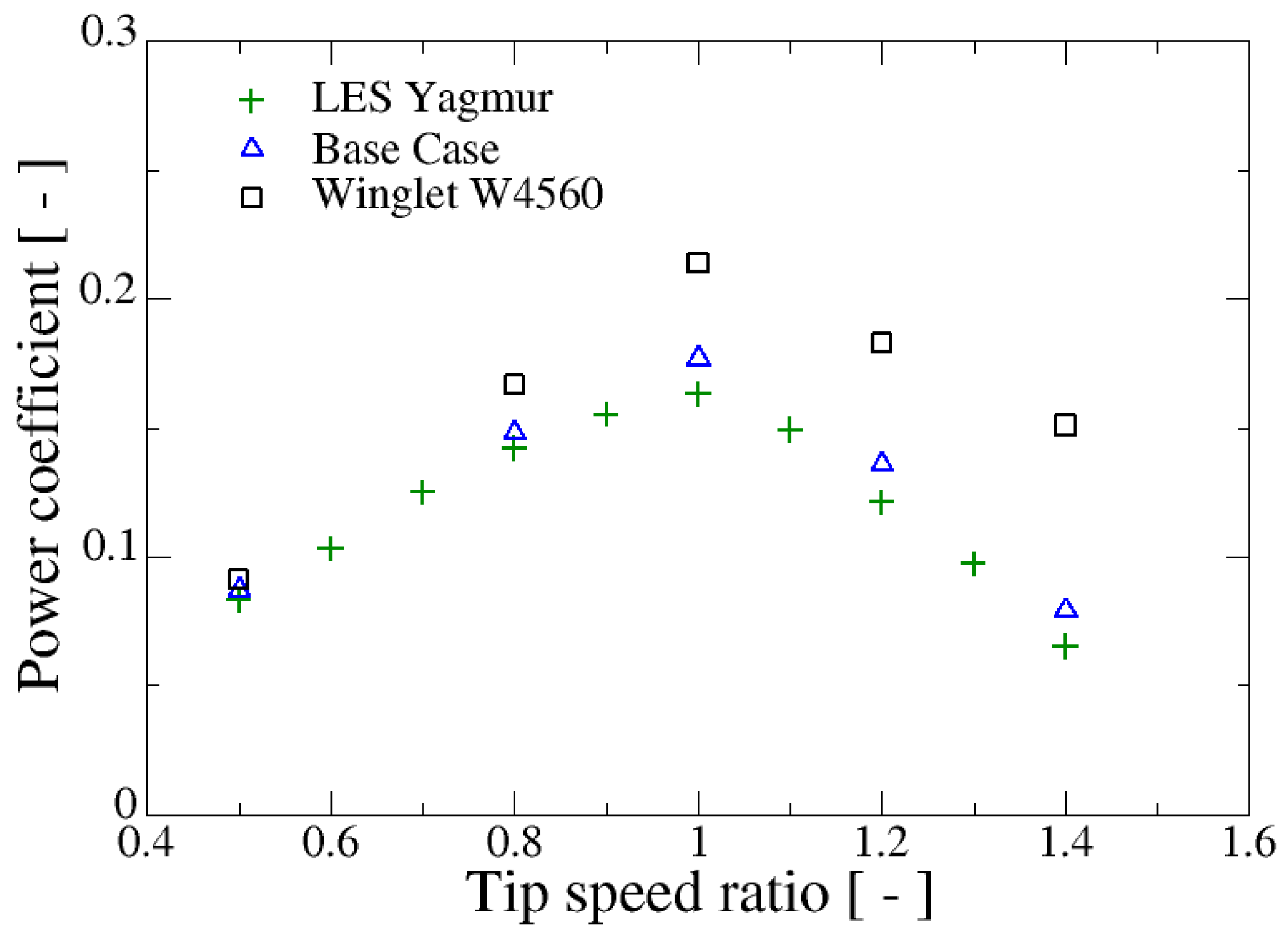
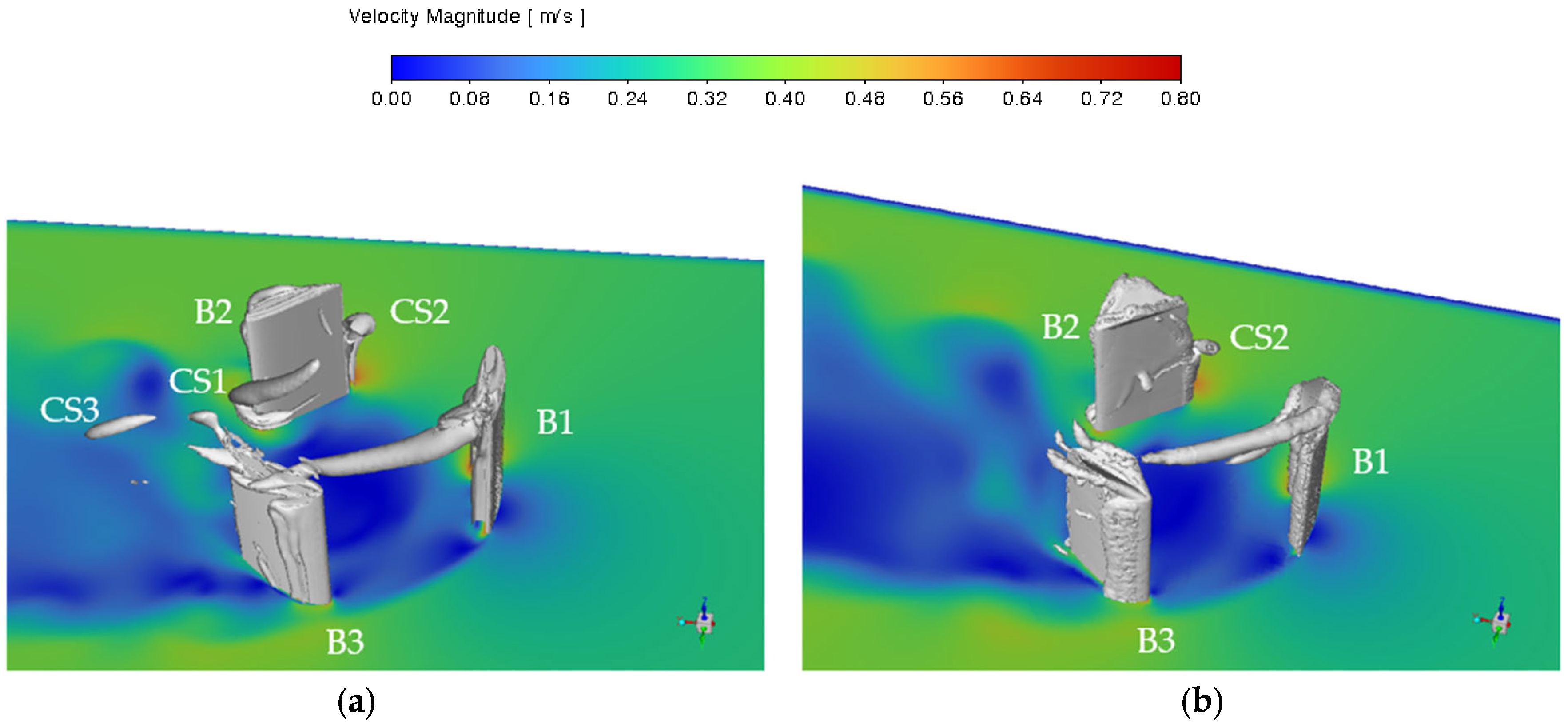
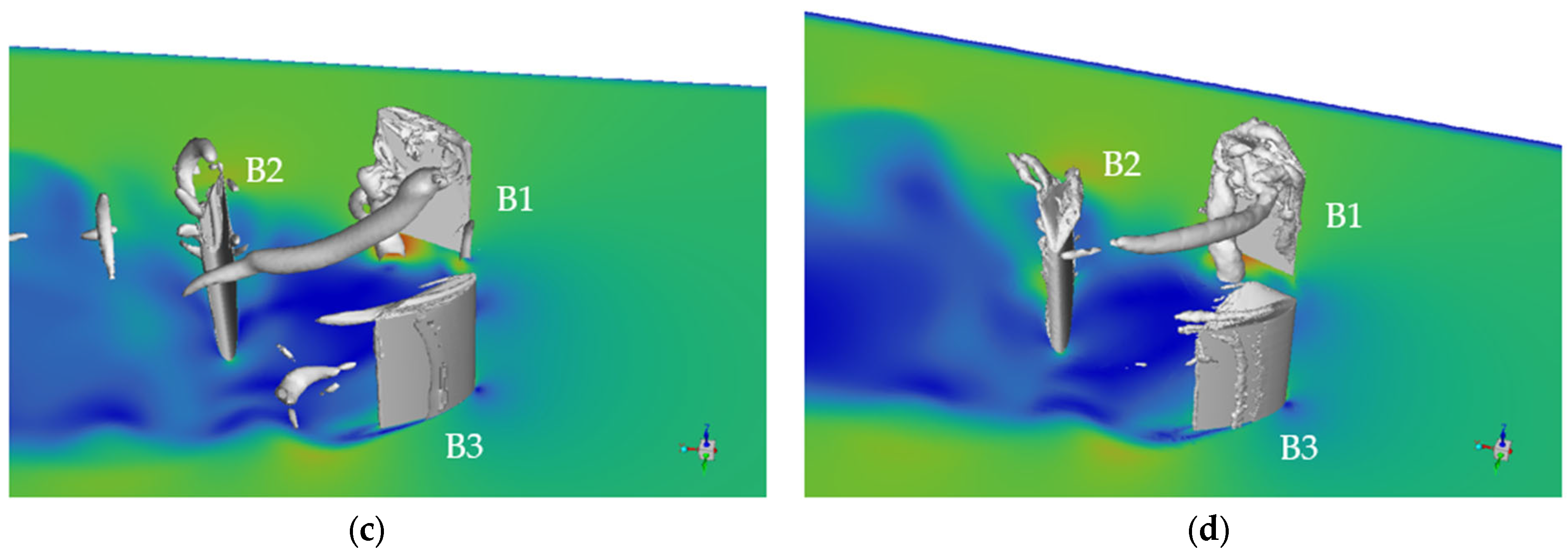


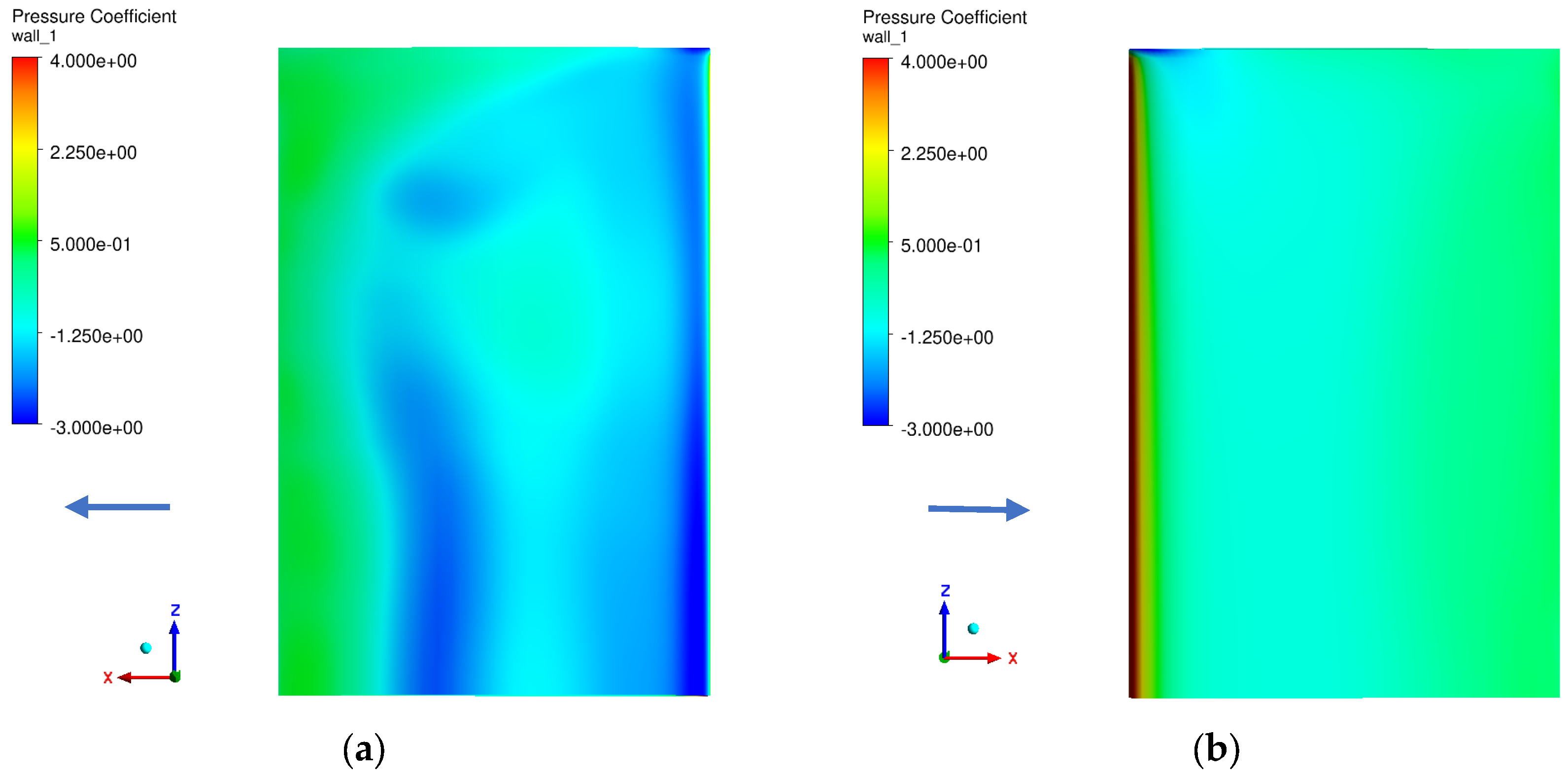
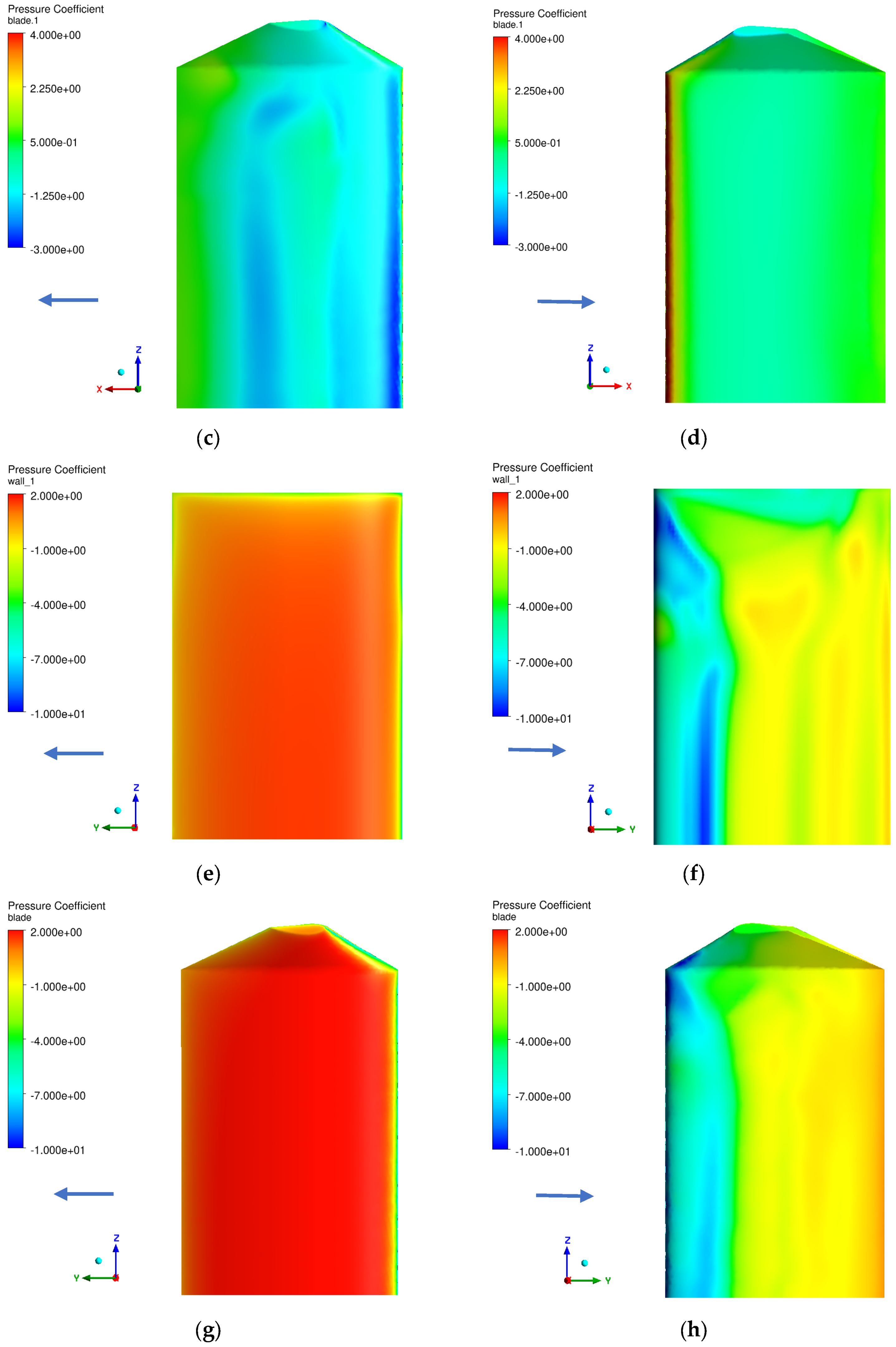
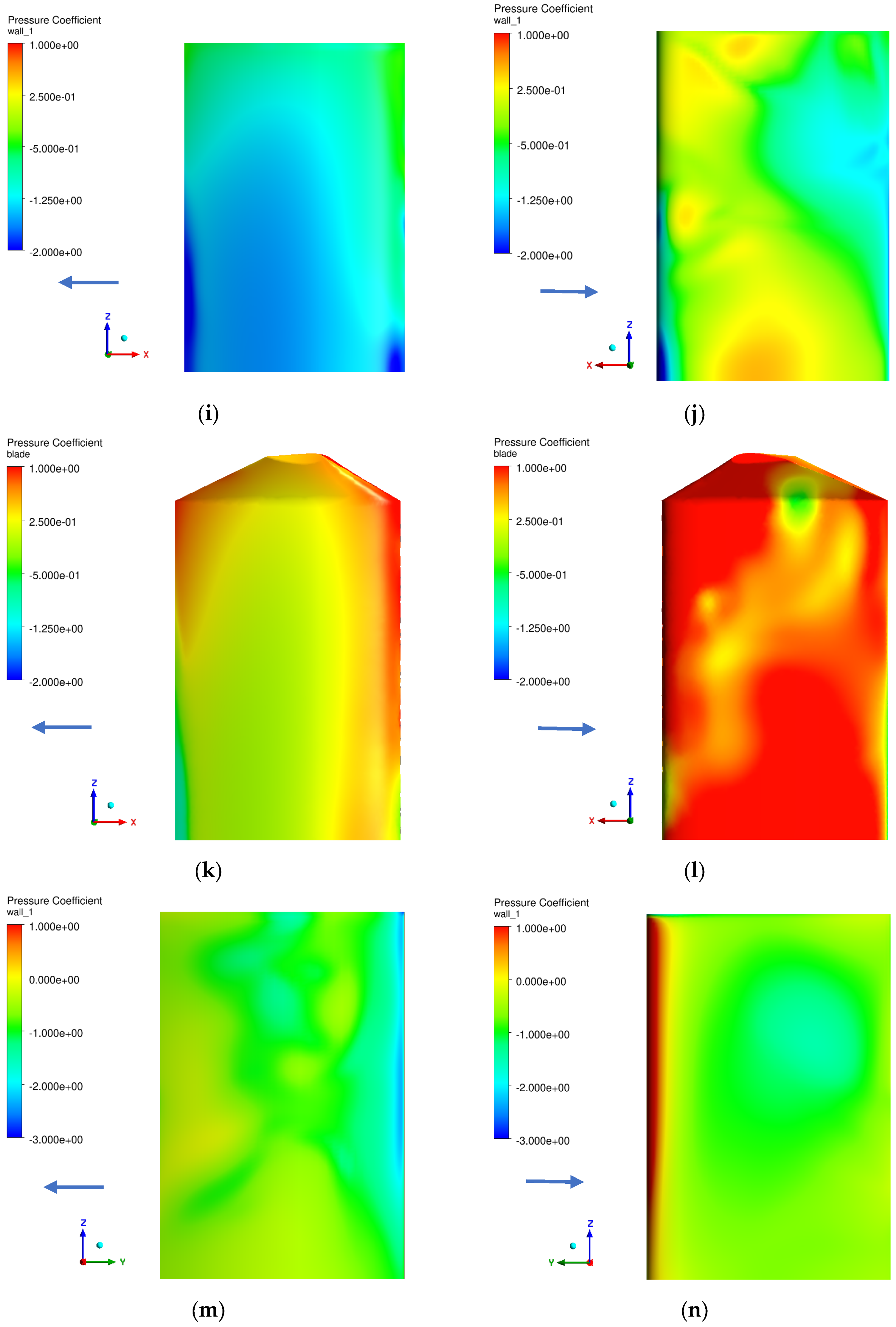
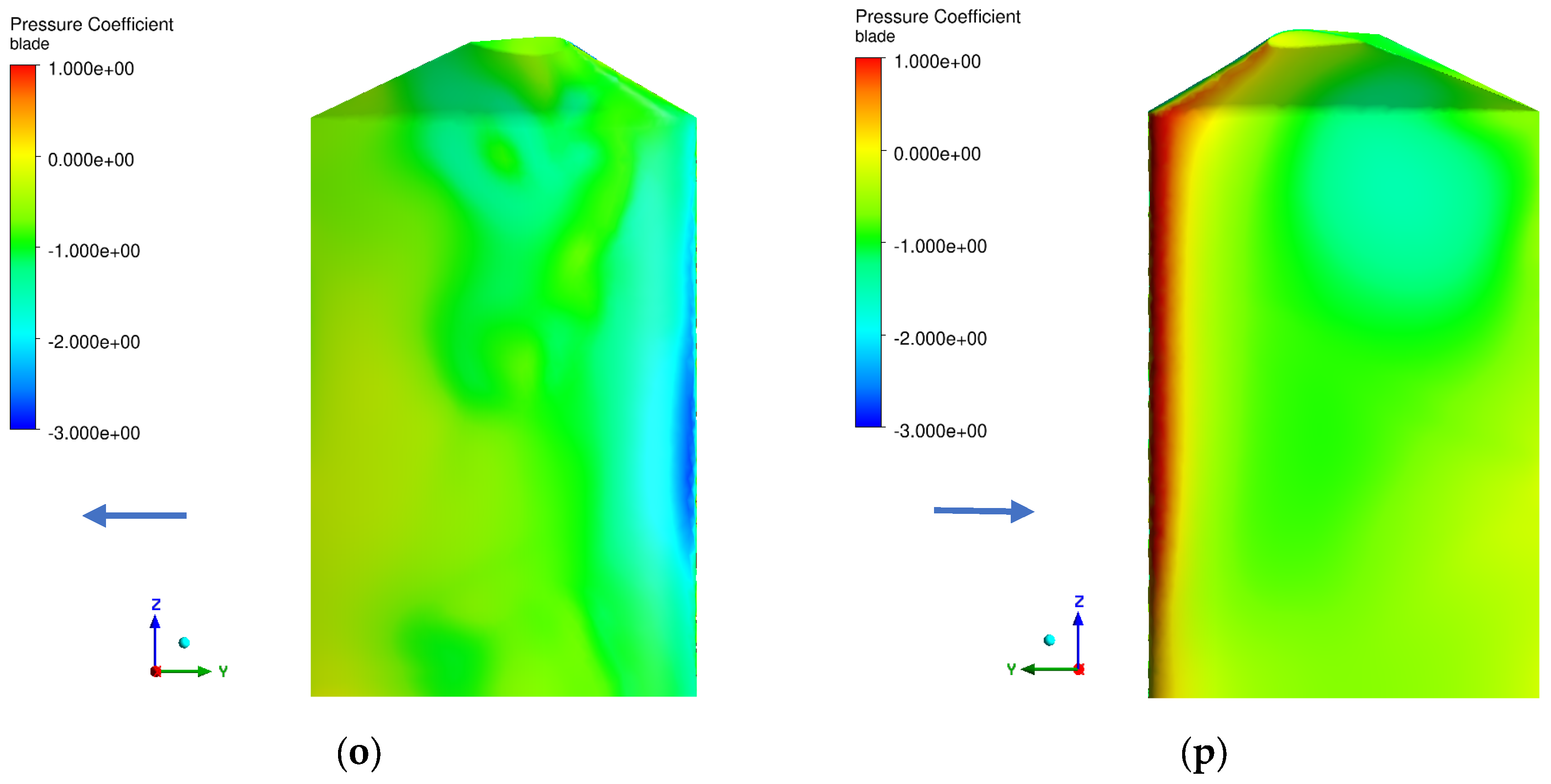

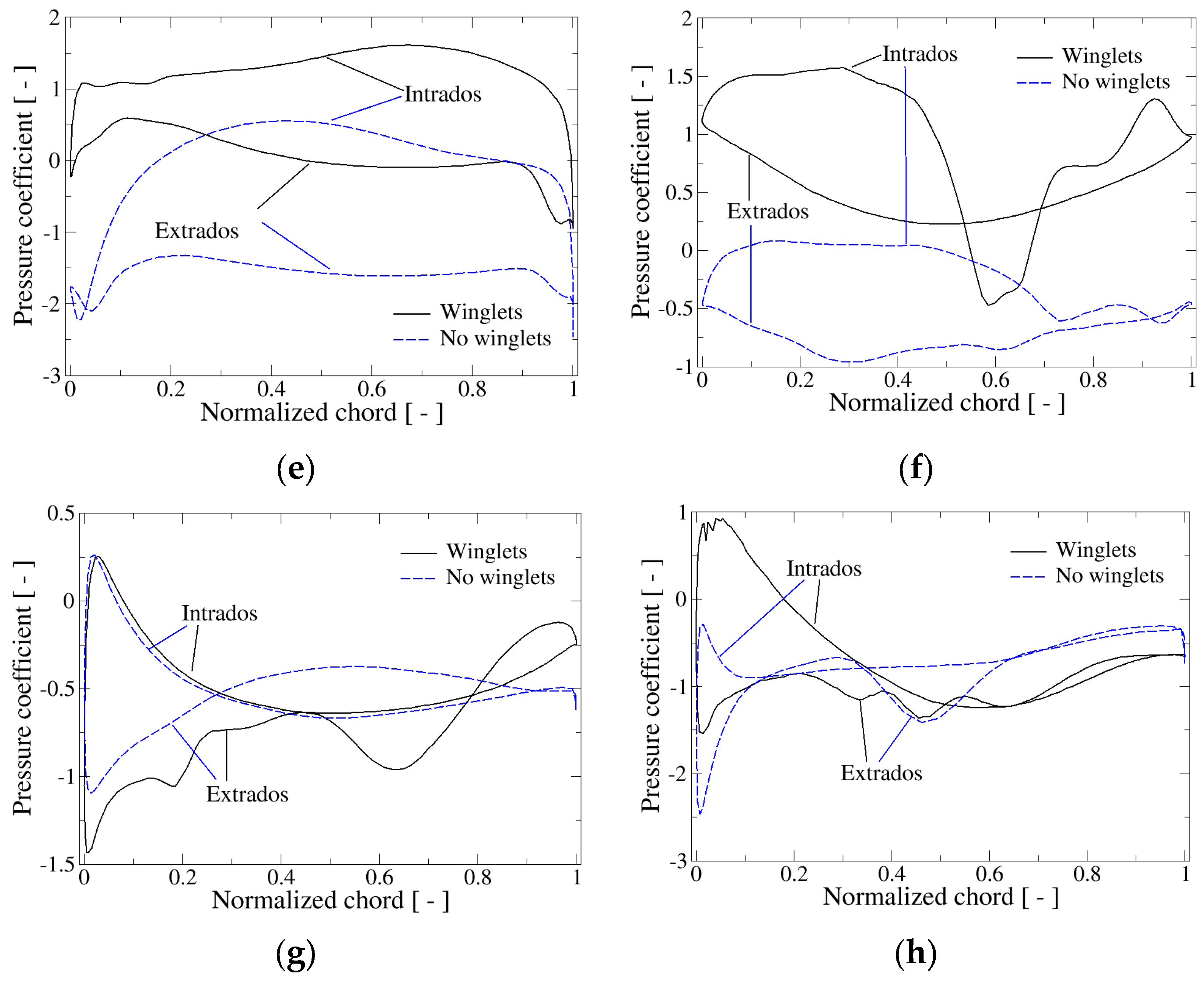
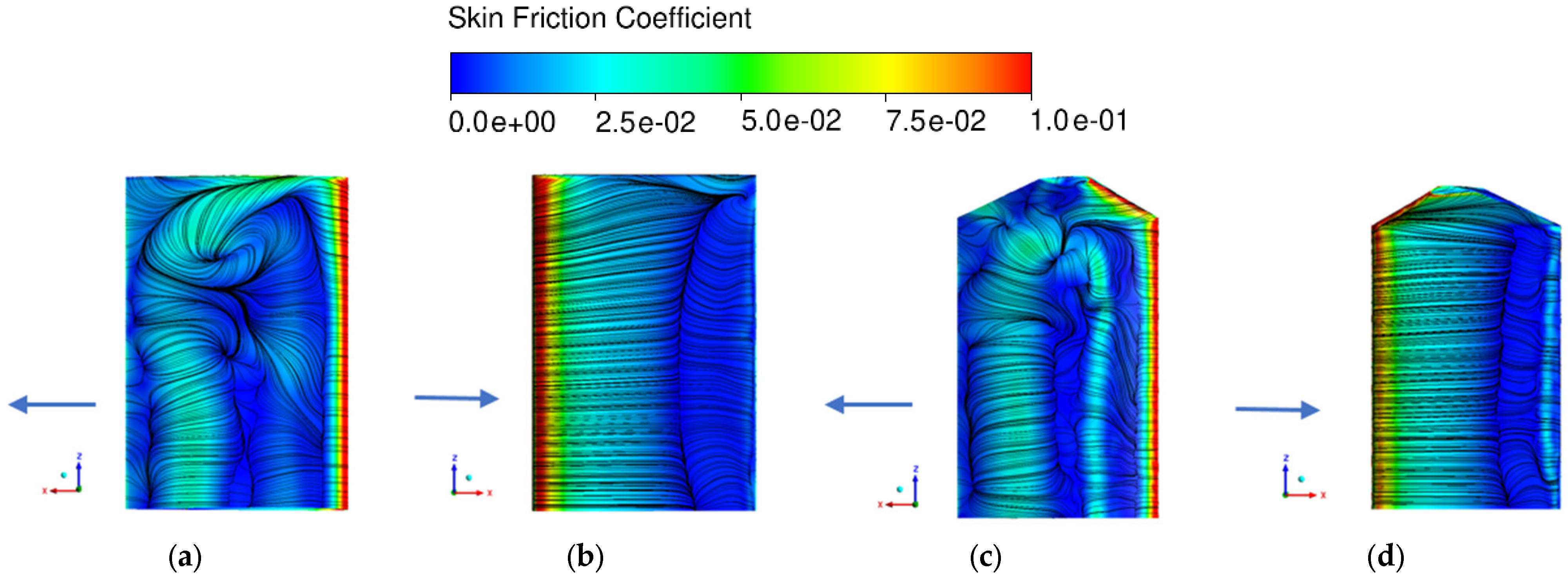
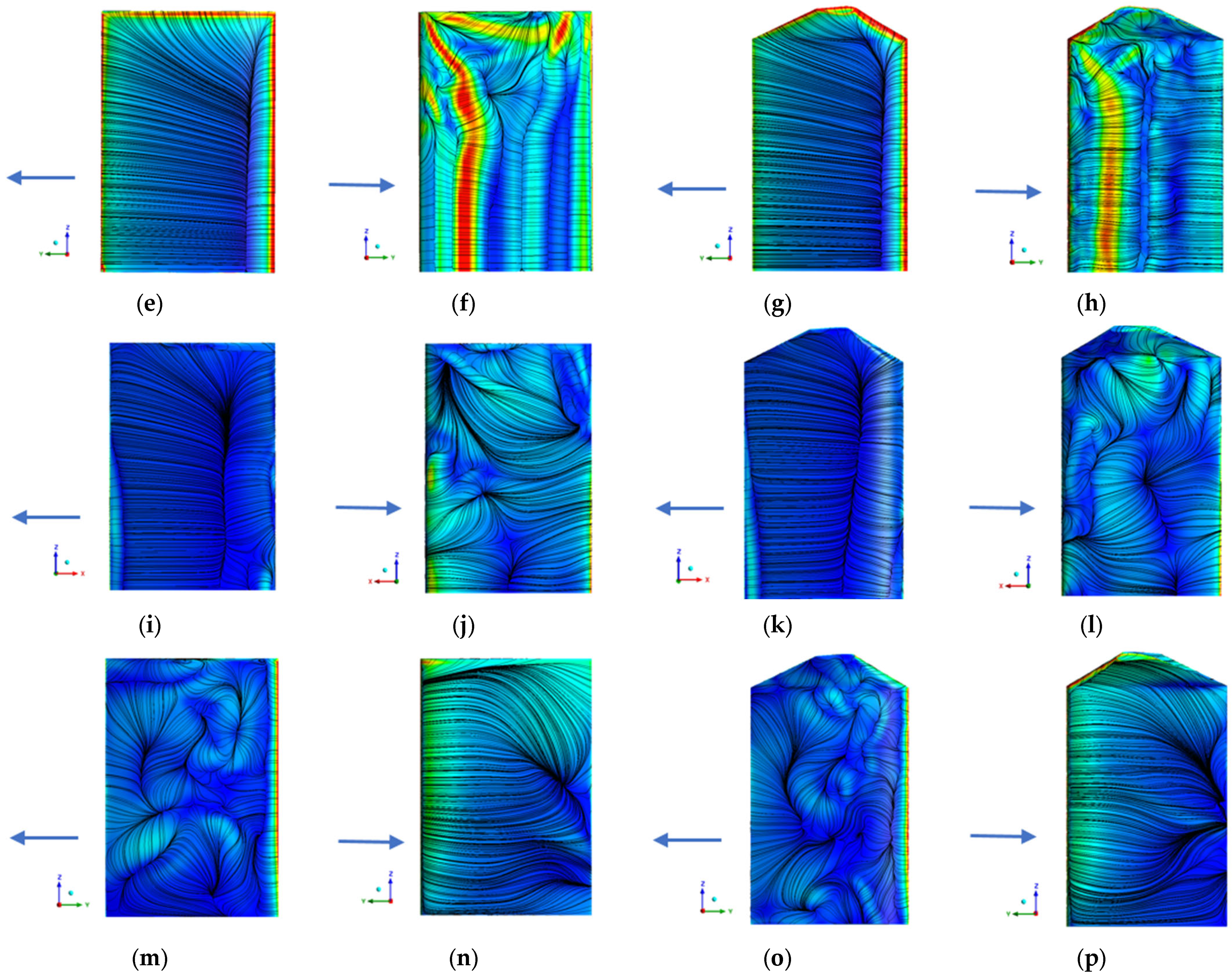
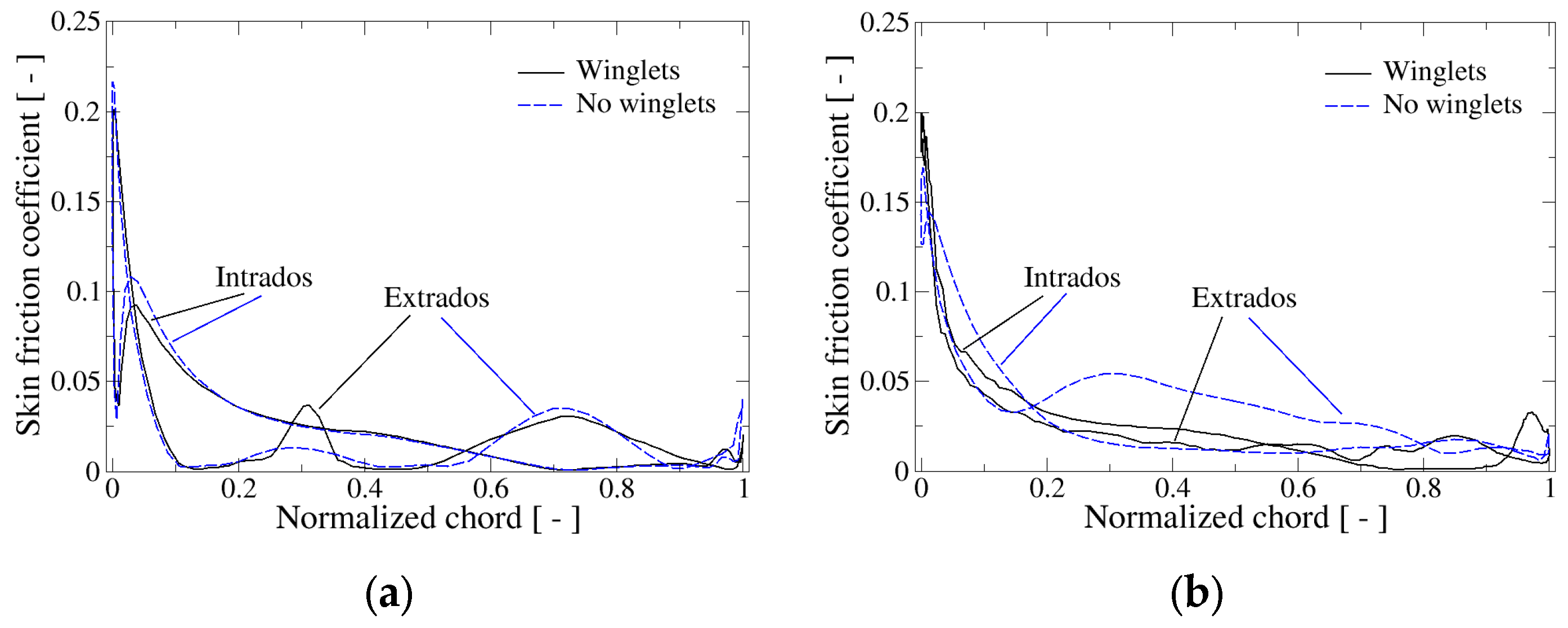
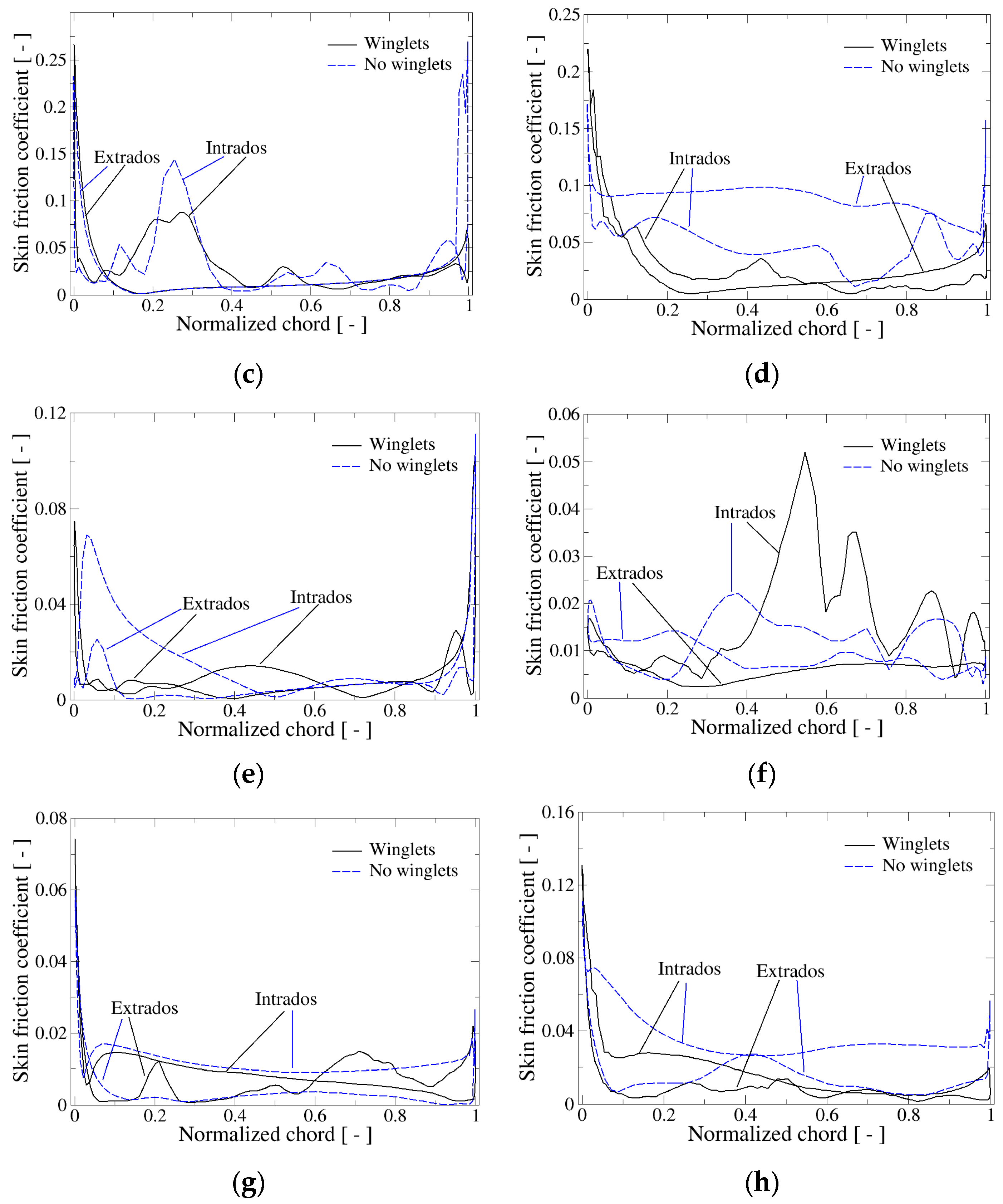
| Parameter | Value |
|---|---|
| NACA profile of the blades | NACA4418 |
| Turbine radius [] | 0.125 m |
| Blade span [] | 0.3 m |
| Chord length | 0.1 m |
| Number of blades | 3 |
| Solidity | 2.4 |
| Winglet Model | Winglet Height | Chord Length | Cant Angle | Sweep Angle |
|---|---|---|---|---|
| Model 1 | 7% of the blade span | 25% of blade’s chord length | 15° | 60° |
| Model 2 | 30° | 60° | ||
| Model 3 | 45° | 60° | ||
| Model 4 | Best angle from models 1 to 3 | 45° | ||
| Model 5 | Best angle from models 1 to 3 | 75° |
| Mesh | Number of Cells in Rotational Domain | Number of Cells in Stationary Domain | Total Number of Cells | |
|---|---|---|---|---|
| Coarse | 1 | 367,848 | 1,540,140 | 1,907,988 |
| Fine | 0.5 | 703,080 | 2,156,196 | 2,859,276 |
| Extra-fine | 0.2 | 1,174,812 | 2,926,166 | 4,100,978 |
| Parameter | Value |
|---|---|
| Free-stream Velocity [] | 0.3 m/s |
| Turbine Angular Velocity [] at | 2.4 rad/s |
| Time step | 0.00364 s |
| Iterations per time step | 30 |
| Residuals convergence criterion | |
| Time discretization | Second order implicit |
| Spatial discretization | Second order upwind |
| Type of Coupling | Segregated |
| Coupling scheme | SIMPLE |
| Grid | Number of Cells | Average Power Coefficient |
|---|---|---|
| Coarse | 1.90 M | 0.166 |
| Fine | 2.86 M | 0.170 |
| Extra fine | 4.10 M | 0.171 |
Disclaimer/Publisher’s Note: The statements, opinions and data contained in all publications are solely those of the individual author(s) and contributor(s) and not of MDPI and/or the editor(s). MDPI and/or the editor(s) disclaim responsibility for any injury to people or property resulting from any ideas, methods, instructions or products referred to in the content. |
© 2024 by the authors. Licensee MDPI, Basel, Switzerland. This article is an open access article distributed under the terms and conditions of the Creative Commons Attribution (CC BY) license (https://creativecommons.org/licenses/by/4.0/).
Share and Cite
López, O.D.; Botero, N.; Nunez, E.E.; Laín, S. Performance Improvement of a Straight-Bladed Darrieus Hydrokinetic Turbine through Enhanced Winglet Designs. J. Mar. Sci. Eng. 2024, 12, 977. https://doi.org/10.3390/jmse12060977
López OD, Botero N, Nunez EE, Laín S. Performance Improvement of a Straight-Bladed Darrieus Hydrokinetic Turbine through Enhanced Winglet Designs. Journal of Marine Science and Engineering. 2024; 12(6):977. https://doi.org/10.3390/jmse12060977
Chicago/Turabian StyleLópez, Omar D., Nicolás Botero, Emerson Escobar Nunez, and Santiago Laín. 2024. "Performance Improvement of a Straight-Bladed Darrieus Hydrokinetic Turbine through Enhanced Winglet Designs" Journal of Marine Science and Engineering 12, no. 6: 977. https://doi.org/10.3390/jmse12060977





